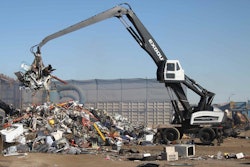LNG is the best alternative transportation fuel of the future, company says
With a project due to start this summer, Shell has given notice that it intends to develop and promote liquefied natural gas (LNG) as the best alternative to diesel for the heavy truck transportation market.
The first of these projects is centered around the LNG plant that Shell is currently building at its Jumping Pound gas processing facility in the foothills of Alberta, Canada. Shell will transport LNG from the plant to a series of Flying J truck plazas along a route dubbed the Canadian Green Corridor.
Shell will initially truck in LNG from third parties, but by the third quarter of next year will be supplying them with LNG from the Jumping Pound LNG plant.
Why LNG? “We believe it is the fuel of the future,” says James Burns, general manager LNG for Transport Americas. “It is abundant, affordable, and available.” And the benefits he cites are considerable. Compared to diesel, LNG:
- Produces 20 percent fewer greenhouse gas emissions
- Costs roughly 30 percent less
- It is produced domestically
- It contains no sulfur, less corrosive and creates fewer engine deposits.
- Extends equipment life and reduces maintenance
Shell has been in the global LNG business for almost 50 years. But new applications of technology, such as hydraulic fracing in shale gas deposits, has made gas supplies more readily available in North America to allow for the economic production of LNG. This year, for the first time ever, Shell will be producing more natural gas globally than oil as the world’s reliance on natural gas increases.
“Five years ago we were importing LNG,” Burns says. “Today, supply is so great, the industry is looking at exporting LNG.”
Unlike compressed natural gas (CNG), which has to be pressurized to 3,500 psi, LNG is natural gas cooled to 260-degrees Fahrenheit / 160-degrees Celsius turning it into a liquid. It then can be stored as a liquid in insulated tanks without further refrigeration, taking up 1/600 the volume compared to its gaseous state.
LNG does not, however, have the same energy density of diesel fuel. A Cummins Westport engine in a Class 8 truck designed to run on LNG will get about 3.8 mpg. The diesel version of that engine would get about 6.5 mpg. CNG, the least energy dense, gets only 1.7 mpg, Burns says.
That makes LNG about 60 percent less energy dense than diesel. The solution for trucks is to add 60 percent more volume in fuel storage space, or limit the number of miles the truck goes between fill ups.
When you compare the costs of LNG to diesel, you need to understand the term “diesel gallon equivalents,” which is not a measure of volume, but rather energy content. To get one diesel gallon equivalent of LNG, you would need approximately 1.6 gallons of LNG. In other words, 1.6 gallons of LNG has the same energy content and will take you an equal number of miles down the road as will 1 gallon of diesel.
That being said, a diesel gallon equivalent of LNG can be about 30 percent less expensive than diesel—and that math appeals to trucking companies. Burns did not get into the specifics of payback, but mentioned that for a truck with a five year lifecycle a likely scenario would be that the reduced fuel costs save you enough money to pay for extra expense of the LNG engine in three years. In the remaining two years the 30 percent reduction in fuel costs goes straight to your bottom line.
On the downside, LNG capable engines are more expensive and Burns cautions that LNG isn’t for everyone. Today, refueling stations are scarce, and that means most LNG powered trucks will initially be those used in hub and spoke operations or travel in the corridors where the fuel is available. Burns speculates that perhaps in five years there may be enough LNG filling stations for truckers to go coast to coast.
Even though it does not require refrigeration while stored, a small amount of the LNG will boil off as natural gas over time increasing the pressure of the LNG tank so you don’t want to spec a truck to use LNG if it’s going to regularly sit unused for long periods of time. Burns says that in today’s environment LNG is better suited as a fleet fuel and sold via contract, rather than something an owner-operator would pursue, since fleets would most likely have more consistent routes. Shell is also looking into the possibility of offering LNG for large customers that keep their own fuel on site.












